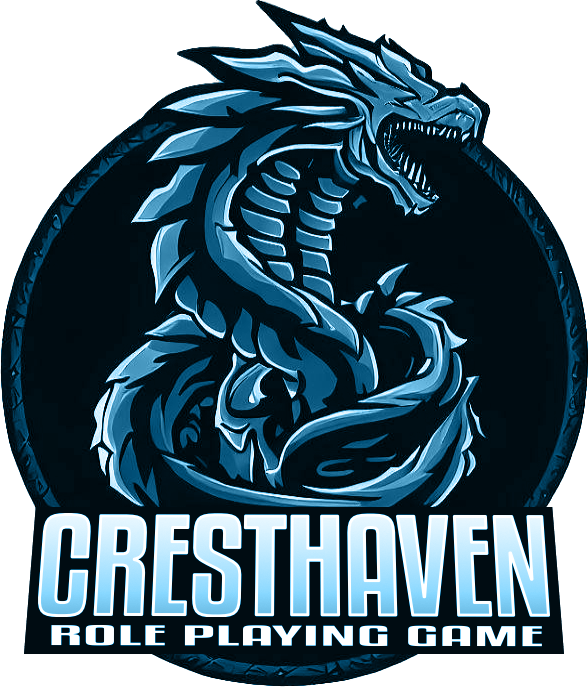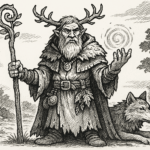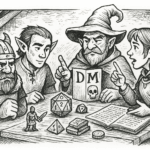A dungeon is any place where monsters and treasures may be found: caves, castles, ruins, or stranger places conjured by imagination. But great dungeons are more than collections of rooms and corridors. They are living environments that challenge, respond, and adapt to the adventurers who dare enter them. This guide is meant to teach you how to build such places: not just to list features, but to help you think as a dungeon maker.
Quick Start: Building a Dungeon in Five Steps
- Choose a Location Seed – caves, ruins, sewers, crypts.
- Draw the Map – use loops, multiple entrances, leave blanks.
- Stock the Dungeon – monsters, traps, treasures, puzzles.
- Add Pressures – track time, scarcity, noise, light.
- Layer Encounters – provide combat, social, exploration, and moral challenges.
Once you have these five, you can run a dungeon. The rest of this guide shows you how to make it great.
What Makes a Great Dungeon
A good dungeon feels like it belongs in the world. Its design has logic. Every monster, treasure, and hazard exists for a reason. Randomly generated caves can still become compelling dungeons if you stock them thoughtfully. If goblins live in a cavern system, then perhaps they herd giant beetles for food, use glowing fungi as torches, and fight over pools of clean water. The more natural these connections feel, the stronger the sense that the dungeon is real.
The danger of a dungeon is tied to its depth or “level.” The first level should pose threats that cautious adventurers can overcome: vermin, kobolds, weak undead, and modest treasures. As explorers press deeper, the threats become stranger and more dangerous, and the rewards greater. This escalation should feel like peeling back layers of mystery, each step forward carrying heavier consequence.
Always ask yourself: who built this place, or who claimed it? What did they want, and how does the dungeon now reflect their presence? These questions make your design stronger than any table of random monsters could.
Location Seeds
Every dungeon begins with a spark of inspiration. Choose a setting that instantly suggests dangers, themes, and moods:
- A network of natural caves beneath an ancient hollowed-out tree
- A long-forgotten cellar beneath a bustling inn
- The ribcage cathedral within a massive dragon’s corpse
- A mad wizard’s trap-laden experimental facility
- Festering sewers beneath the city’s foundations
- A fortress carved entirely from a stone mountain
- Haunted catacombs within a mound shaped like a giant skull
- The forgotten crypt of a mad king
- An evil cult’s temple hidden beneath a legitimate church
- The remains of a city buried under volcanic rock
When you write your own seed, describe both the physical environment and the kind of stories it encourages. A fortress carved into a mountain suggests discipline, armies, and defense. Festering sewers beneath a city suggest filth, secrecy, and disease. The crypt of a mad king might hold tragic echoes of royalty and tyranny. A cult’s temple beneath a legitimate church practically writes its own moral dilemmas. The seed is not the whole dungeon, but it gives you a theme to build upon.
Draw the Map
Graph paper is still the dungeon designer’s best tool. Pick a scale: one square equals five feet for interiors, twenty feet for large outdoor spaces. Then begin sketching shapes that fit the setting you chose. If you are making caves, do not worry about symmetry. Draw irregular chambers with bulging walls, twisting tunnels, and dead ends. If you are making a castle or a wizard’s laboratory, impose order: squares, circles, symmetry, and layered defenses.
The best maps provide choices. Create loops where corridors reconnect. Offer multiple entrances. Allow for shortcuts, blocked passages, or locked doors that tempt players to take risks. And most importantly, do not feel pressured to fill every inch of the paper. Leave some gaps and unfinished areas so you can invent on the fly when players explore in unexpected ways.

The Dungeon Checklist
When stocking a dungeon, test your design against a simple checklist:
- Something to Steal – Treasures worth risking danger
- Something to Kill – Monsters that challenge the party
- Something to Kill You – Serious threats that demand respect
- Different Paths – Multiple routes encouraging exploration
- Someone to Talk To – NPCs for roleplay and information
- Something to Experiment With – Interactive elements and mysteries
- Something Hidden – Secrets the party might never discover
- Environmental Hazards – Dangers beyond monsters
- Puzzles and Challenges – Problems requiring thought over violence
- One Inexplicable Thing – Something that sparks wonder and questions
Equally important is the dungeon’s ecology. Think about the inhabitants as if they were real. Where do they eat and sleep? What do they fear? Do they trade or fight with one another? Orcs might keep goblin servants. A vampire might keep thralls. A fungus colony might provide food for smaller creatures. These details transform a dungeon from an empty maze into a living world.
Types of Dungeons
Not all dungeons are the same. The physical layout, hazards, and underlying purpose of a location change how players experience it. Choosing a dungeon type helps you focus your design, set expectations, and reinforce the adventure’s themes.
Cat and Mouse Dungeon
Core Element: Movement, evasion, and pursuit inside a hostile space.
This dungeon is alive with something hunting the characters. The goal is not simply to explore, but to outwit, evade, or corner a threat that adapts as players move through the environment. It may be a stalking predator, an intelligent guardian, or an unstable magical hazard.
Strengths: High tension, dynamic pacing, strong thematic identity.
Best For: Horror adventures, time-sensitive missions, stories with a singular monstrous foe.
Design Tips:
- Build looping routes and multiple chokepoints so pursuit feels real.
- Place evidence of the hunter before direct confrontation.
- Add environmental cues (scratches, spoor, flickering torches snuffed out) to build pressure.
- Give players options to hide, ambush, or misdirect, not just fight.
Gauntlet Dungeon
Core Element: Sequential, escalating challenges.
Every room or corridor presents a test: trap, puzzle, or combat. The structure is linear, but the pressure comes from endurance. Can the party survive the whole sequence?
Strengths: Easy to pace, strong sense of progress, natural for tournament or one-shot play.
Best For: Groups that like clear goals and mechanical challenge.
Design Tips:
- Vary challenge types to avoid monotony.
- Seed hints of upcoming dangers so players can prepare.
- Manage resource drain such as light, spells, and healing to create suspense.
Lair Dungeon
Core Element: A central enemy and its supporting ecosystem.
The dungeon exists to house one primary foe such as a dragon, necromancer, or cult leader. The environment reinforces their nature and provides context for the final confrontation.
Strengths: Clear narrative focus, memorable climax, logical enemy structure.
Best For: Adventures with a strong villain or singular threat.
Design Tips:
- Design minions and defenses that reflect the villain’s personality.
- Build the environment to suit their nature, such as lava chambers, fungal warrens, or bone-strewn crypts.
- Ensure the villain is active in the dungeon, not just waiting in the last room.
Puzzle Box Dungeon
Core Element: Spatial logic and hidden mechanisms.
Players progress by solving how the dungeon itself works. Secret doors, shifting passages, magical locks, and environmental riddles turn the location into a puzzle to be unraveled.
Strengths: Highly interactive, rewards exploration and deduction.
Best For: Groups who enjoy problem-solving and exploration over combat.
Design Tips:
- Make sure every puzzle has multiple clues or solutions.
- Use recurring motifs or symbols to tie puzzles together.
- Layer puzzles with resource tension such as burning torches or patrolling enemies so progress feels urgent.
Living Dungeon
Core Element: A place that changes as the players explore it.
This dungeon reacts to intruders. Monsters migrate, traps reset, and factions shift territory. Time matters, and leaving and returning may present a completely different situation.
Strengths: High replay value, strong sense of realism.
Best For: Sandbox campaigns and long-form adventures.
Design Tips:
- Track time and resource use carefully.
- Use random encounter tables and the Tension Pool to show the dungeon fighting back.
- Make players feel their actions ripple through the ecosystem.
Designing Living Dungeons
A dungeon is not just a backdrop; it is an adversary. Every passage, chamber, and hazard should work together to make the place feel hostile, unpredictable, and alive.
The Environment as Adversary
Terrain can shape every encounter. Design your dungeon’s terrain to favor its inhabitants and challenge your players’ assumptions about movement and positioning.
Difficult Terrain forces tactical decisions. Mud, debris, or water slows movement to half speed and limits attacks to every other round. Place it strategically to separate melee fighters from spellcasters or create chokepoints.
Unstable Ground requires a Dexterity save (DC 8). In combat, check at the start of each character’s round. During exploration, check at the start of each turn. Failure means falling Prone: half movement, attacks at disadvantage, enemies gain Advantage. This can be devastating during combat.
Elevation Changes reward positioning. Higher ground often grants Advantage at the DM’s discretion. Design multi-level encounters where controlling the high ground becomes crucial.
Narrow Passages force formation changes. Single-file corridors prevent the party from using their usual tactics and make retreat dangerous.
Vertical Challenges demand resource investment. Climbing surfaces typically require checks around DC 10. Failure risks 1d6 falling damage per 10 feet, cumulative. Smart parties bring rope and pitons: unprepared ones suffer.
Always ask how the terrain favors the dungeon’s inhabitants over the intruders.
Time as Pressure
Time is the dungeon’s sharpest weapon. A round (1 minute) is one minute and a turn (10 minutes) is ten minutes. Torches burn down. Spells expire. Monsters patrol. Rivals advance toward the same treasures.
Each time the players rest, the dungeon has a chance to change: guards regroup, traps are reset, doors are barred, and opportunities are lost. Do not let the dungeon sit idle; let it push back against delay.
Track time ruthlessly:
- Torches and lanterns burn out
- Spells expire
- Wandering monsters patrol
- Resources dwindle
- The dungeon responds to intrusion
Use time pressure to force difficult choices between thorough exploration and resource conservation.
Optional Rule: The Tension Pool Consider using the Tension Pool mechanic to structure when complications arise. As tension builds through time passage, failed rolls, and risky actions, trigger escalating consequences: equipment failures, monster patrols repositioning, structural collapses, or other dungeon responses that make delay increasingly dangerous.
Sound and Consequences
Noise is another pressure. Sound carries through stone. A splintering door or a pitched battle may summon reinforcements from nearby chambers. When players make noise, decide who hears it, how far away they are, and how long they take to arrive. The dungeon is never deaf.
Use noise to:
- Trigger ambushes from adjacent rooms
- Alert guards to reposition or reinforce
- Drive intelligent enemies to prepare countermeasures
- Force fleeing creatures to set traps ahead of the party
Consider the dungeon’s acoustics when placing encounters. Stone amplifies sound; earth muffles it.
Scarcity and Resource Management
Scarcity ties it all together. Rations spoil. Water grows foul. Ammunition runs out. Unless players state otherwise, assume spent resources are lost. This forces them to weigh every decision. Do they risk a final torch, or press forward in darkness? Do they drink the last waterskin, or save it for later? Scarcity makes the dungeon feel unforgiving and real.
Track consumables without mercy!
Resting in Dungeons: Short Rests take 1 hour. Long Rests take 8 hours and consume 1 ration and 1 waterskin (per the Resting page). Both expose the party to wandering monsters and give the dungeon time to respond. Rest too often or too long, and the world moves on without you: enemies reinforce, traps are reset, opportunities vanish.
Light and Shadow
Light is both safety and vulnerability. A torch creates a small island of vision, but also marks the party’s presence for anything watching from the dark. Beyond its reach lies constant danger.
Normal Light: No penalties to perception or action.
Low Light: Creatures without darkvision have disadvantage on sight-based Wisdom checks; creatures with darkvision see normally.
Darkness: Creatures without darkvision gain the Blinded condition; creatures with darkvision see normally.
Magical Darkness: Negates all vision, including darkvision, unless countered by magic.
Design encounters around light sources. Monsters with Darkvision will extinguish torches and attack from darkness.
Navigation and Disorientation
Exploration is more than walking from one room to the next. It is the constant risk of losing your way. On the surface, roads and landmarks prevent confusion. In wilderness or underground environments, the risk of becoming lost is real. Without careful maps, chalk marks, or guide ropes by the Cartographer role, the party may find themselves circling back to familiar ground or stumbling into areas they meant to avoid. Disorientation should not be a punishment but a pressure, one that makes the players value the role of a cartographer in their group.
The Cartographer role is the party’s best defense against becoming hopelessly lost.
Creating Encounters
Encounters are the pulse of a dungeon. They can be combat, negotiation, discovery, or puzzles; but they always carry risk and consequence. Whether negotiating with a territorial dragon, outwitting cunning thieves, or uncovering ancient secrets, design encounters that offer rich outcomes with combat being just one possibility.
Balancing Challenge
Start by considering the objectives and motivations of beings the players might meet. Experience point values serve as reward measures and rough danger indicators, but they’re not balancing mechanics. A lone ogre may be less dangerous than a cunning band of goblins in prepared ground.
Cresthaven embraces imbalance intentionally. Sometimes players face overwhelming odds that demand retreat, negotiation, or creative solutions. Telegraph serious dangers clearly so players can make informed choices, but don’t scale every threat to their level. Show claw marks on walls, the smell of rot, or the corpses of past adventurers. Hint at wards, heat shimmer, or arcane symbols. These signs give players fair warning. Whether they press forward, detour, or retreat is their choice.
Wandering Monsters
Wandering monsters are not filler. They are the dungeon asserting itself, forcing the party to spend time and resources. Use them to create unpredictability and reinforce the sense of a living world. Not tied to specific locations, they can appear at any moment. Sometimes they will be simple threats, but they can also be rivals, scouts, or creatures with knowledge the party needs. Always roll with intent.
Obstacles and Barriers
Doors, traps, and secrets are not distractions. They are part of the dungeon’s voice.
Doors
Every door presents a tactical decision between stealth, time, and noise.
Picking Locks: Dexterity check (Thieves use Lockpicking skill). Simple Average (DC 10), standard Tough (DC 15), masterwork Challenging (DC 20). Thieves’ tools grant their Lockpick Advantage bonus.
Forcing Entry: Strength check that takes 1 round per attempt, advances the clock, and creates noise. Wooden doors are typically Tough (DC 15), reinforced doors Challenging (DC 20) or higher.
Secret Passages
Spend 1 full turn to search. Wisdom (Search) against DC 17 (per standard searching). Beat the DC by 5 or more to reveal the mechanism. The DM rolls secretly.
Secret doors should not exist merely for treasure: they should provide shortcuts, escape routes, or hidden stories.
Listening
Wisdom (Listen): DC 17 (per standard listening). Beat by 5+ to identify the creature type. Thieves may substitute their Listen skill. Takes 1 round (1 minute). Armor may impose disadvantage.
Exceeding the DC by 5+ identifies the type of creature making the sound.
Traps
Traps are lessons written in steel and stone. They punish haste and force resource loss. Design them with clues: scorch marks for fire traps, holes in the walls for darts, or suspicious discoloration for poison gas. Avoid deadly traps until the second level or deeper.
Detection: Searching for traps takes 1d4 rounds (1d4 minutes) per attempt. Wisdom (Search) check. Thieves may use Detect Traps skill. Simple traps might be Average (DC 10), elaborate ones Tough (DC 15) or higher. One attempt per character per location. The DM rolls secretly.
Activation: Some traps require saves to avoid. Others activate automatically when triggered. Use the site’s ability-save mapping for specific save types.
Common Trap Types: Blade Traps: Sweeping blades that may allow Dexterity saves for damage.
Creature Traps: Hidden monsters (snakes, beetles, spiders) that get one free surprise attack.
Dart Traps: Spring-loaded mechanisms shooting darts for damage or effects (paralysis, poison, curse). Either automatic hits or require attack rolls.
Explosions: Area damage with Dexterity save for half. If illusory, use Wisdom (disbelief).
Falling Objects: Blocks or rubble requiring Dexterity saves to avoid damage. May be triggered by touch or randomly.
Fog Traps: Looks like poison gas but causes various effects on failed Wisdom save: nothing, giggles, fear, terrible smell for 1d6 turns (may attract monsters), anger (victims attack each other 1d4 rounds), or paralysis.
Light Traps: Bright flash blinds all who see it for a time (Wisdom save applies, may have bonuses/penalties).
Pit Traps: Floor sections that give way, causing 1d6 falling damage per 10 feet. May contain spikes for extra damage, deep water, monsters, or be chutes leading to next dungeon level.
Poison Gas: Poison Gas: Wisdom save to avoid the effect. For ingested or injected poison, call for a Constitution save instead.
Poison Needles: Small, nearly undetectable needles that spring out when something is opened or touched.
Special Encounters
Not all dangers are simple monsters or traps. Some are stranger. Beyond normal monsters, traps, and treasures, special encounters add memorable moments:
Environmental Hazards
- Alarms: Summon special monsters, open doors, or create false effects
- Falling Damage: 1d6 per 10 feet, Dexterity Save for half
- Map Changes: Shifting walls cut off exits, forcing new routes
- Movement: Rooms, stairs, or doors that move unexpectedly
- Magical Pools: Strange effects from touching or drinking
- Sounds: Rooms that moan, scream, or talk
- Statues: Valuable, magical, alive, or concealing secrets
- Transportation: Trap doors, elevators, magical portals
Dangerous Organisms
Gelatinous Cube (AC 10, HP 24): Clear jelly in 10×10×10 foot cube form. Hard to see, surprises often. Successful hits paralyze unless Constitution Save made. Dissolves organic material but may contain undissolvable treasures. Vulnerable to fire and weapons, immune to cold and lightning.
⚠️ See the Gelatinous Cube Encounter example here!
Green Slime: Immune to all attacks except fire and cold. Dissolves cloth and leather instantly, wood and metal in 6 rounds. Drops from ceilings by surprise. Turns flesh to green slime unless burned off or treated with Cure Disease. Burning does half damage to both slime and victim.
Lurker/Trapper: Giant stone manta rays that ambush from ceiling (Lurker) or floor (Trapper). AC 10, 4 HD (24 HP). Very Tough (DC 20) difficulty to spot before ambush. Ambush envelops victims, causing 1d8 ongoing acid damage and destroying equipment.
Yellow Mold: Yellow mold looks like a gold blanket over anything. It covers 10 square feet, killed only by fire (1d4 damage per torch per round). When touched, there is a 50% chance to release 10×10×10 foot spore cloud. Victims take 1d6 damage and must make Constitution Save (DC 8) or choke to death in 6 rounds.
💡See the complete Guide to Utilizing Slimes, Puddings, and Molds in Encounters
Illusions and Tricks
- Phantom Features: Stairs, rooms, doors, or monsters that aren’t really there
- Trick Monsters: Variations like skeletons that shoot fingertips, two-headed ogres, or “goop” dragons
- Weird Magic: Anti-gravity areas, size changes, or impossible creatures
Beyond Combat
The dungeon breathes between battles. These encounters create breathing room between fights while maintaining tension:
Social Encounters: Prisoners, rival parties, intelligent monsters open to negotiation
Puzzles and Mechanisms: Locked chambers, mechanical contraptions, riddles, interactive statues
Moral Choices: Cursed items, trapped innocents, situations where not everyone can be saved
Exploration Challenges: Managing hunger, thirst, failing light, or navigating without landmarks
These moments reward cleverness, empathy, and foresight. They remind players that dungeons are not only measured by what you kill, but by how you endure, what you learn, and the marks you leave behind. Design these encounters to reward creative thinking over dice rolling. They should feel like natural parts of the dungeon’s ecosystem, not arbitrary obstacles.
Design Philosophy
At every step, remember: nothing in a dungeon should be arbitrary. Every element should serve a purpose, even if that purpose is only to unsettle or intrigue. Ask yourself:
- How does this challenge force the players to adapt their usual tactics?
- What resources will this encounter consume?
- How does this obstacle reflect the nature of the dungeon’s creators or inhabitants?
- What meaningful choices does this present to the players?
A dungeon should feel like it existed before the party arrived and will continue to exist after they leave. Every trap, monster, and treasure should have a reason for being there beyond “the adventure requires it.”
The best dungeons tell stories through their design: stories of the civilizations that built them, the creatures that claimed them, and the adventurers who dared to explore them. When players emerge from your dungeon, they should carry memories not just of what they fought, but of a place that felt real, dangerous, and alive.
Continuing Guides:
Additional Reading
A Guide to Utilizing Slimes, Puddings, and Molds in Encounters
Wandering Monsters Level Up Your Dungeon Game
A Comprehensive Role-Playing Game Encounter Guide
Railroading Players: Striking a Balance Between Story and Agency
Breathing Life into Your Dungeons
Making Sure Everyone Gets a Turn: How to Be Heard in Your Game
This Post Has One Comment
Leave a Reply
You must be logged in to post a comment.






Awesome